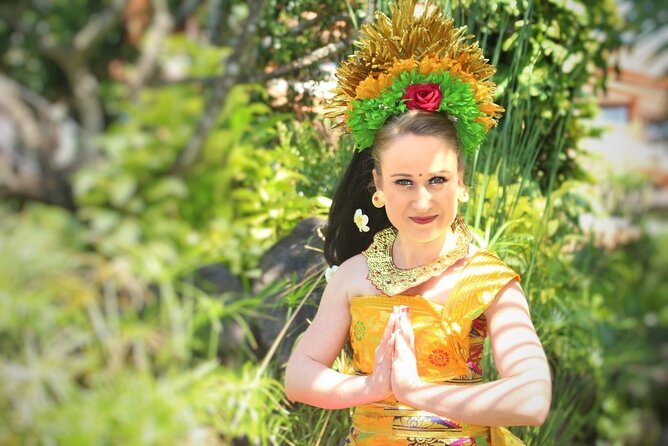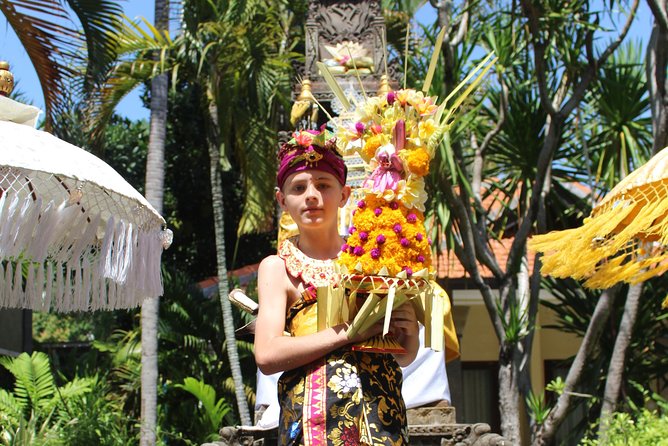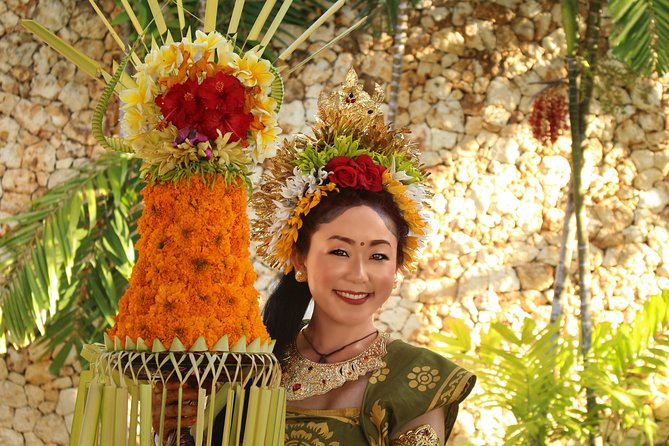Indulge in the intricate tapestry of Balinese culture through an exploration of the captivating Balinese Traditional Costume. Each garment donned by the Balinese people carries a profound significance, intertwining history, spirituality, and artistry into a mesmerizing display of tradition.
From the elaborate headdresses to the meticulously crafted fabrics, every element of the traditional attire tells a story waiting to be unraveled, offering a glimpse into the island’s rich heritage.
Prepare to be enchanted by the secrets woven into these costumes, beckoning you to uncover the hidden depths of Balinese sartorial tradition.
Good To Know

- Balinese traditional attire reflects centuries of cultural evolution and regional diversity.
- Symbolic motifs, vibrant colors, and intricate craftsmanship are integral to Balinese traditional costumes.
- Dressing in Balinese attire signifies spirituality, tradition, and respect for cultural heritage.
- Modern influences blend with traditional elements to create unique and adaptable Balinese outfits.
History of Balinese Traditional Costume

How did the enchanting Balinese traditional costume evolve over the centuries, reflecting the rich cultural tapestry of the island’s history?
The evolution of Balinese traditional attire is a testament to the cultural fusion that has shaped the island. With regional variations adding depth to the costume’s allure, each area showcases its unique style, colors, and patterns.
From the intricate Kebaya worn by women to the elegant Songket fabrics adorning ceremonial occasions, Balinese traditional attire is steeped in symbolism and tradition. Over time, these costumes have become synonymous with the island’s vibrant festivals and rituals, embodying the spirit and essence of Balinese culture.
The history of Balinese traditional costume is a living tapestry woven with threads of heritage and innovation.
Find more activities and experiences we've covered in Jimbaran.
Elements of Balinese Traditional Attire

Reflecting the intricate cultural heritage of Bali, the elements of Balinese traditional attire are a vibrant tapestry of colors, symbols, and craftsmanship that encapsulate the island’s rich cultural identity. Influential designs like the intricate songket weaving, bold batik patterns, and elaborate gold or silver thread embroidery are prominent features of Balinese traditional dress.
These designs aren’t merely decorative but hold deep cultural symbolism, with motifs representing aspects of nature, Hindu mythology, and local beliefs. The use of specific colors such as bright yellows, whites, and blacks also play a significant role in conveying meanings and social status.
Every detail in Balinese traditional attire is meticulously crafted to honor tradition and showcase the island’s unique cultural flair.
Significance of Balinese Dressing Style
The intricate elements of Balinese traditional attire not only showcase the island’s rich cultural identity but also carry significant symbolism that reflects the deep-rooted traditions and beliefs of the Balinese people.
Balinese dressing style holds immense cultural symbolism, with each garment and accessory representing aspects such as spirituality, social status, and connection to nature.
The fashion trends in Balinese attire are deeply influenced by centuries-old customs and rituals, blending traditional designs with modern aesthetics. The colors and patterns used in Balinese clothing often symbolize harmony, balance, and protection against negative forces.
The way Balinese people dress also signifies their respect for tradition and their commitment to preserving their cultural heritage.
Modern Influences on Balinese Clothing
Influences from contemporary fashion trends have gradually woven their way into the traditional Balinese clothing, adding a modern flair to the island’s rich sartorial heritage. Modern adaptations can be seen in the vibrant colors, intricate patterns, and styles that blend traditional Balinese elements with modern aesthetics, creating a unique cultural fusion. Balinese outfits now incorporate elements like asymmetrical cuts, contemporary fabrics, and even Western-inspired silhouettes, catering to a broader audience while preserving the essence of Balinese attire. This blend of modern influences with traditional garments showcases the adaptability and creativity of Balinese fashion, reflecting the evolving tastes and preferences of the local community and visitors alike.
| Modern Influences on Balinese Clothing | Examples |
|---|---|
| Vibrant colors | Bright hues in traditional attire |
| Contemporary fabrics | Silk blends for Balinese sarongs |
| Western-inspired silhouettes | Modern cuts in Balinese tops |
Tips for Wearing Balinese Traditional Outfits
For those looking to embrace Balinese culture authentically, mastering the art of wearing traditional Balinese outfits is essential for a truly immersive experience. Here are some tips and benefits for wearing Balinese traditional outfits:
- Respect Cultural Norms: By donning traditional Balinese attire, individuals show respect for the local culture and traditions.
- Enhance Cultural Experience: Wearing Balinese outfits can enhance the overall cultural experience by allowing individuals to blend in with the local community.
- Photography Opportunities: Traditional Balinese outfits make for stunning photographs against the backdrop of Balinese temples and landscapes.
- Comfort and Style: Despite their intricate designs, many Balinese traditional outfits are comfortable to wear and exude a unique sense of style.
- Connect with Locals: Wearing traditional Balinese clothing can help visitors connect with locals on a deeper level, fostering cultural exchange and understanding.
- Ubud in a Day: Rice Terrace, Holy Water Temple, Waterfall, Arts
- Mount Batur Sunrise Trekking and Rice Terrace Adventure
- Sekumpul, Handara, and Ulun Danu Beratan Temple Private Tour – Jimbaran
- Bali Private Inclusive Tour: Best of Ubud in a Day
- Skip the Line : Kecak and Fire Dance Ticket at Uluwatu Temple
- Bali Instagram Tour (All-Inclusive)
Common Questions
Can Tourists Rent or Purchase Balinese Traditional Costumes for Special Events or Ceremonies?
Tourists looking for a cultural experience can typically rent or purchase traditional attire for special events or ceremonies. This allows them to enjoy local fashion trends and participate authentically in Balinese cultural practices.
Are There Specific Rules or Customs Regarding Who Can Wear Balinese Traditional Attire?
Gender roles play a significant role in determining who can wear traditional attire. Cultural appropriation is a concern, and respect for customs is crucial. Family heirlooms are cherished, while modern adaptations keep the attire relevant and accessible.
Are There Any Taboos or Cultural Sensitivities to Be Aware of When Wearing Balinese Traditional Outfits?
One should always respect cultural etiquette when embracing local fashion trends. Understanding taboos and cultural sensitivities is crucial when donning traditional outfits. It fosters appreciation and shows reverence for the heritage and customs of the community.
How Can One Learn More About the Intricate Designs and Symbolism Behind Balinese Traditional Costumes?
To explore the symbolism interpretation and design intricacies of traditional costumes, one can explore local museums, attend cultural workshops, or engage with knowledgeable artisans. Understanding these elements enhances appreciation for Balinese heritage and artistic craftsmanship.
Are There Any Specific Rituals or Ceremonies Associated With the Wearing of Balinese Traditional Clothing?
Specific rituals and ceremonies accompany the wearing of traditional attire in Balinese culture. Their clothing carries deep symbolic meanings and is often worn during significant cultural ceremonies to honor traditions, ancestors, and spiritual beliefs.
The Sum Up
To sum it up, the Balinese Traditional Costume isn’t just a form of clothing, but a reflection of the rich cultural heritage and spiritual beliefs of the people of Bali.
Each garment tells a story, with intricate details and vibrant colors symbolizing the island’s artistic prowess and deep-rooted traditions.
Modern influences may have shaped Balinese clothing, but the essence of these traditional outfits remains unchanged, continuing to captivate and inspire all who experience their beauty.
More Tour Reviews in Jimbaran
Looking for something different? Other Jimbaran activities we've written about
- 2 Best 3 Day Tours In Jimbaran
- 9 Best Workshops And Classes In Jimbaran
- 12 Best Spa And Hot Springs Experiences In Jimbaran
- 20 Best Massage And Relaxation Services In Jimbaran
- 2 Best 2 Day Tours In Jimbaran
- 11 Best Snorkeling Experiences In Jimbaran
- 14 Best Private Driver Services In Jimbaran
- 7 Best Full-Day Tours In Jimbaran
- 9 Best 2 Hour Tours and Experiences in Jimbaran
- 2 Best Guided Tours In Jimbaran
- 2 Best Guided Tours In Jimbaran
- 3 Best Boat Tours And Cruises In Jimbaran
